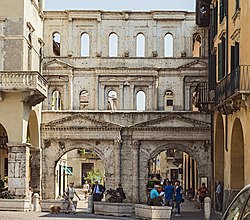| UNESCO World Heritage Site | |
|---|---|
 | |
| Criteria | C (ii) (iv) |
| Reference | 797 |
| Inscription | 2000 (24th Session) |
The monuments of Verona are a vast number of architecturally, archaeologically, historically, and artistically significant cultural assets that characterize the city of Verona. Precisely because of the richness of its monuments and the urban evolution that has developed seamlessly over the centuries, UNESCO declared the city a World Heritage Site in 2000.





























